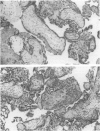Abstract
Recently, there have been several molecular studies of trisomic fetuses and liveborns which have examined the parent and meiotic stage of origin of nondisjunction. However, little is known about the possible phenotypic effects of the origin of trisomy. For trisomic spontaneous abortions, no distinct phenotype has been described, although some have been reported to have features, such as trophoblastic hyperplasia, similar to hydatidiform moles. In the present report, we describe molecular and histological studies of spontaneous abortions with trisomies 2, 7, 15, or 22, conditions occasionally linked to trophoblastic hyperplasia. Our results provide strong evidence for chromosome specific mechanisms of nondisjunction, with trisomy 2 having a high frequency of paternally derived cases and trisomy 7 typically originating postzygotically. In studies correlating parental origin of trisomy with phenotype, we found no difference in the proportion of cases with trophoblastic hyperplasia, fetal tissue, nucleated red blood cells, or hydropic villi among paternally or maternally derived trisomies 2, 7, 15, or 22. However, paternally derived trisomies tended to abort earlier than maternally derived trisomies. This suggests that parental origin might affect the developmental stage at which abortion occurs but not other features of placental phenotype.
Full text
PDF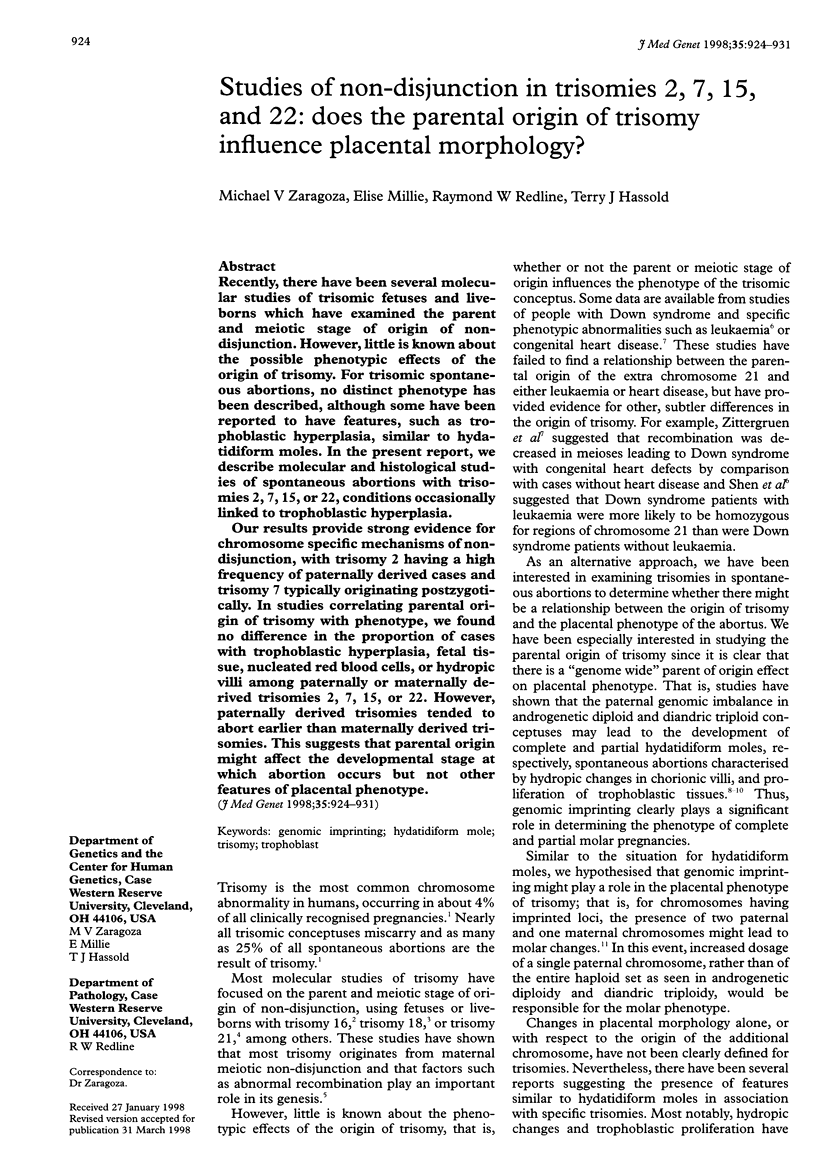
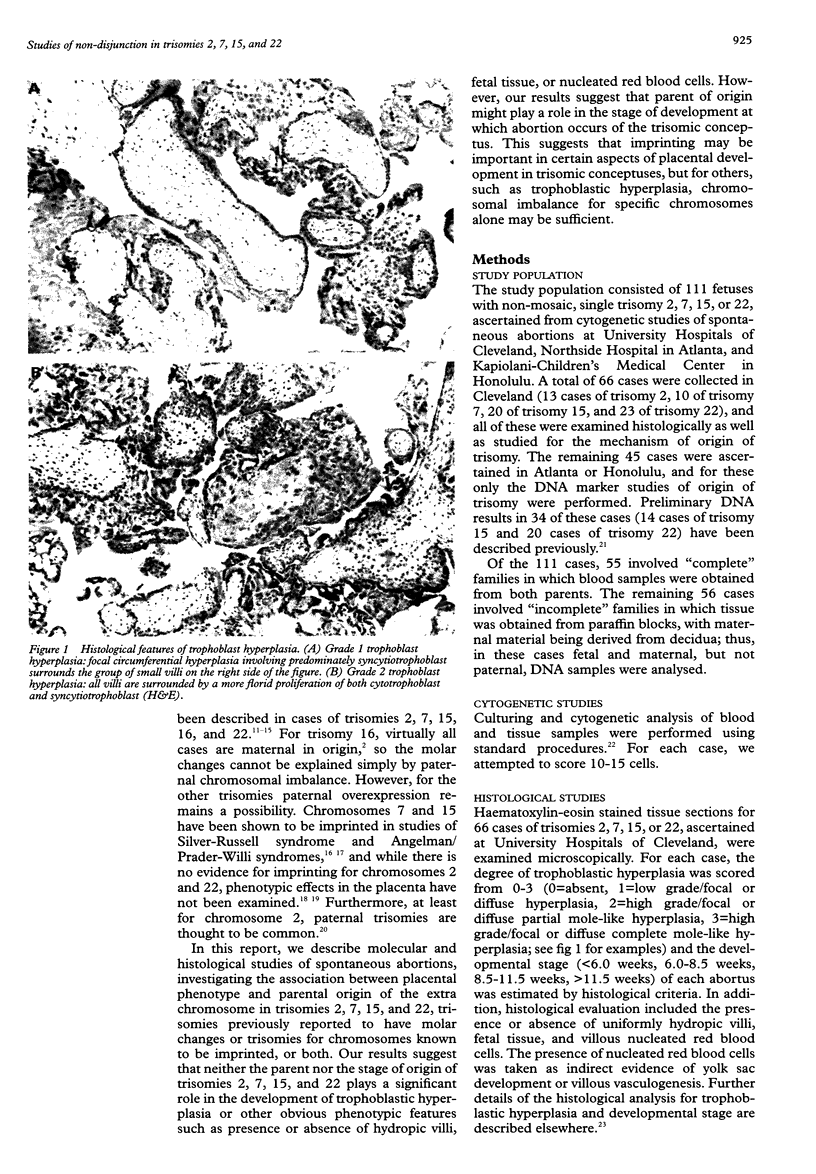
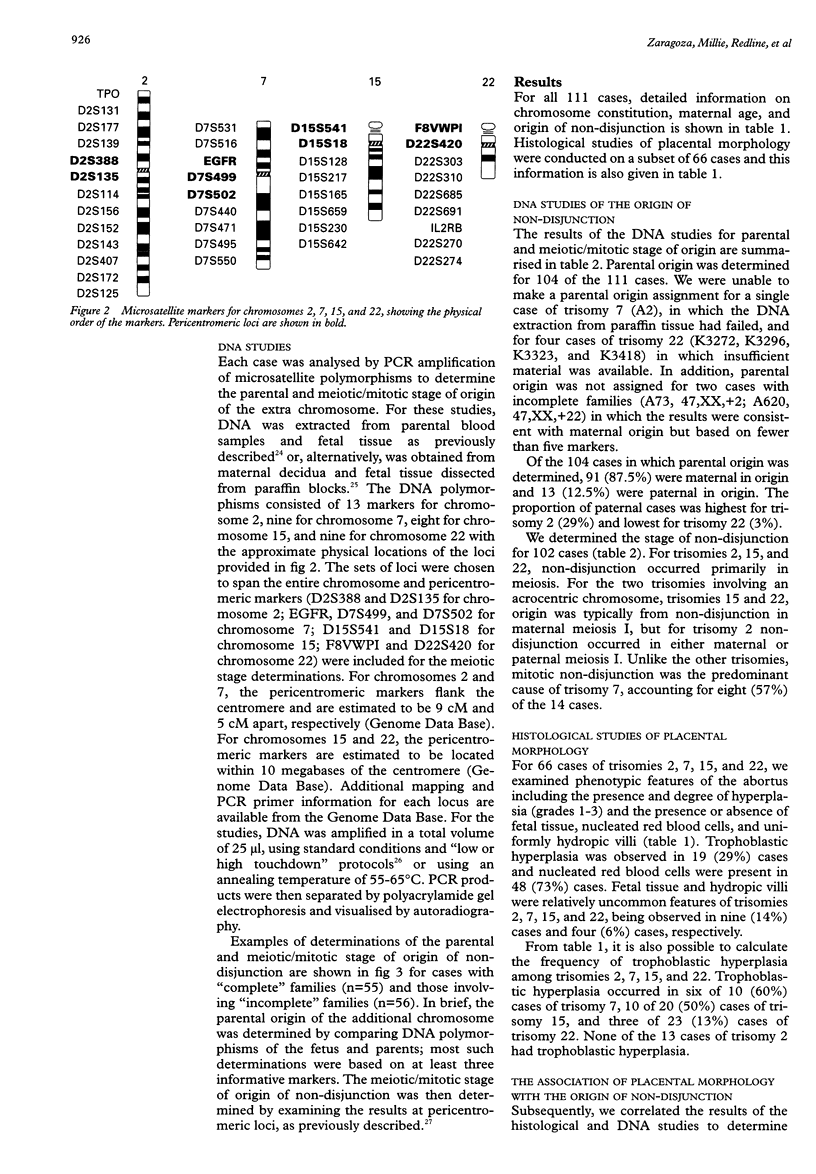
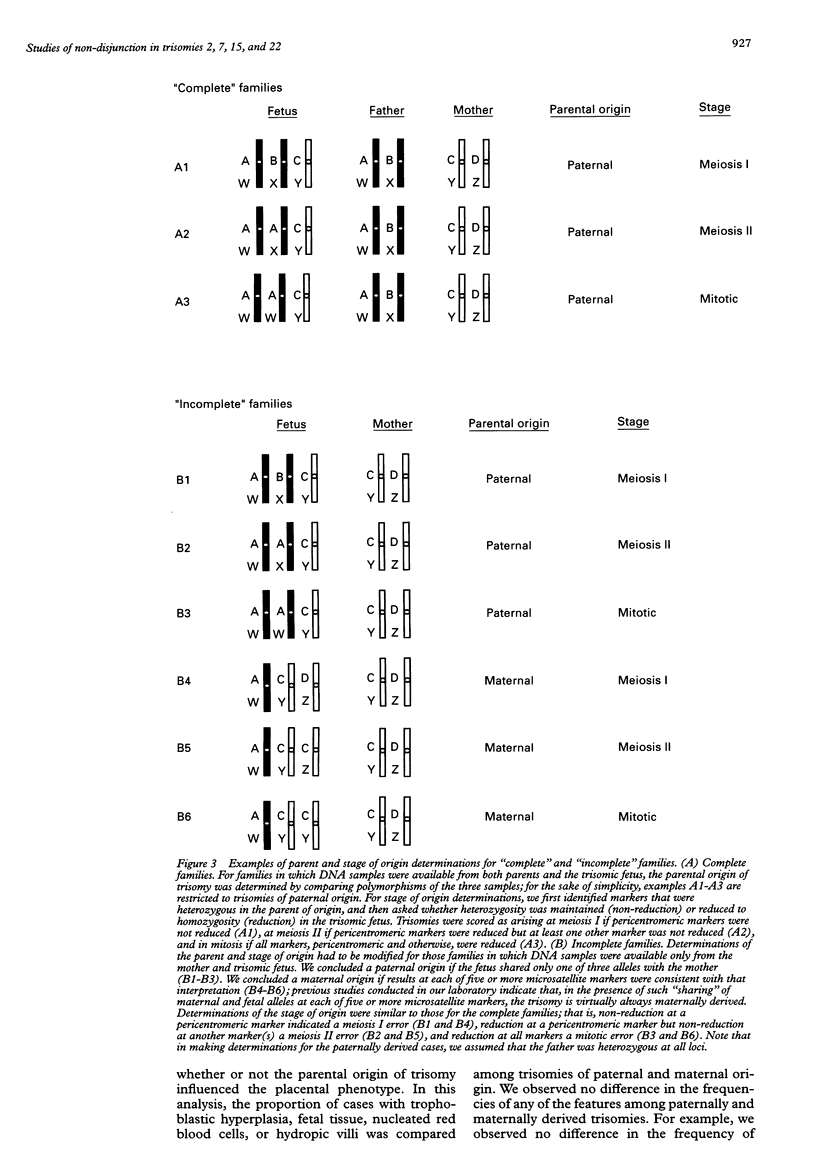
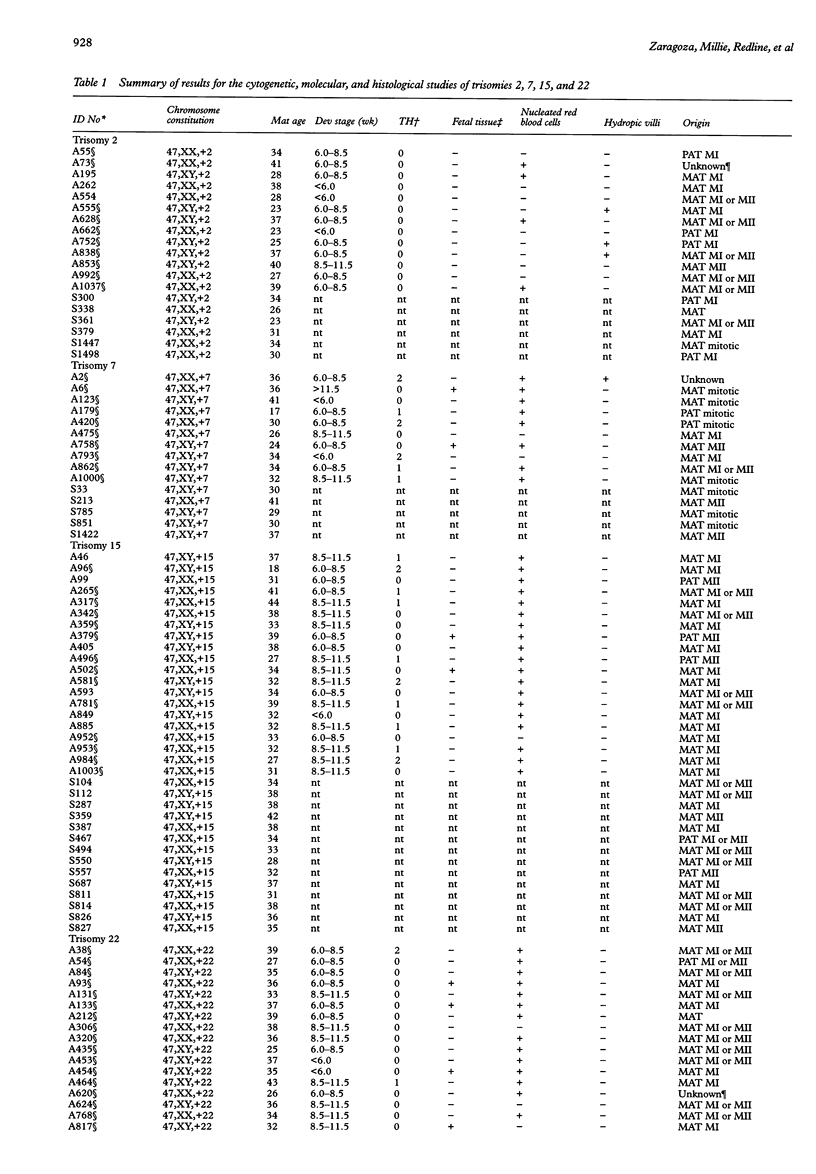
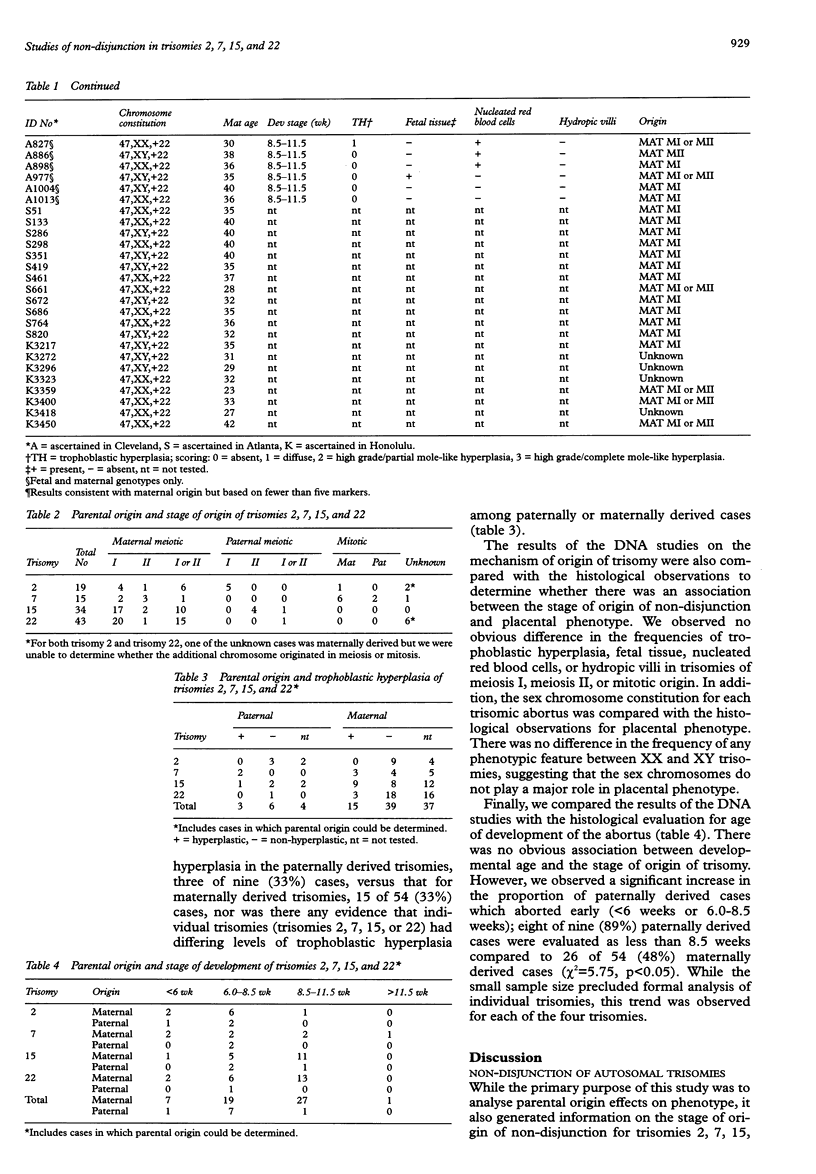
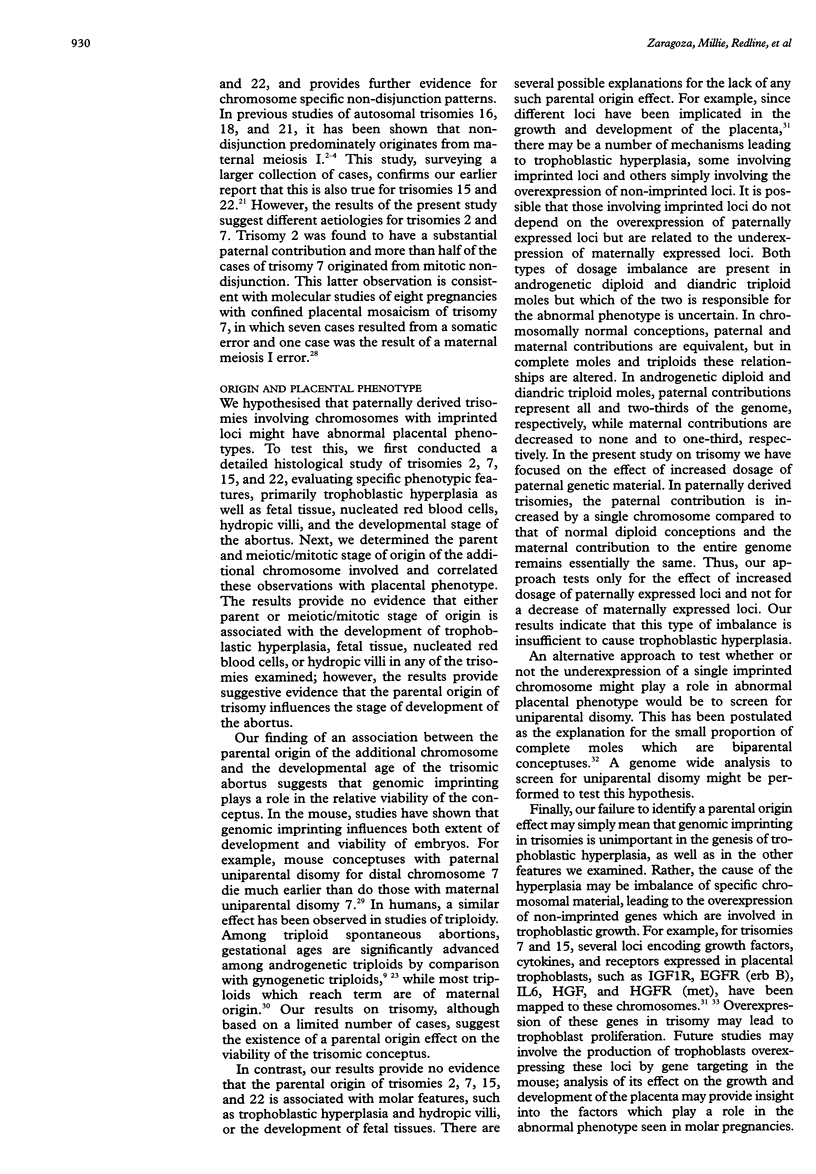
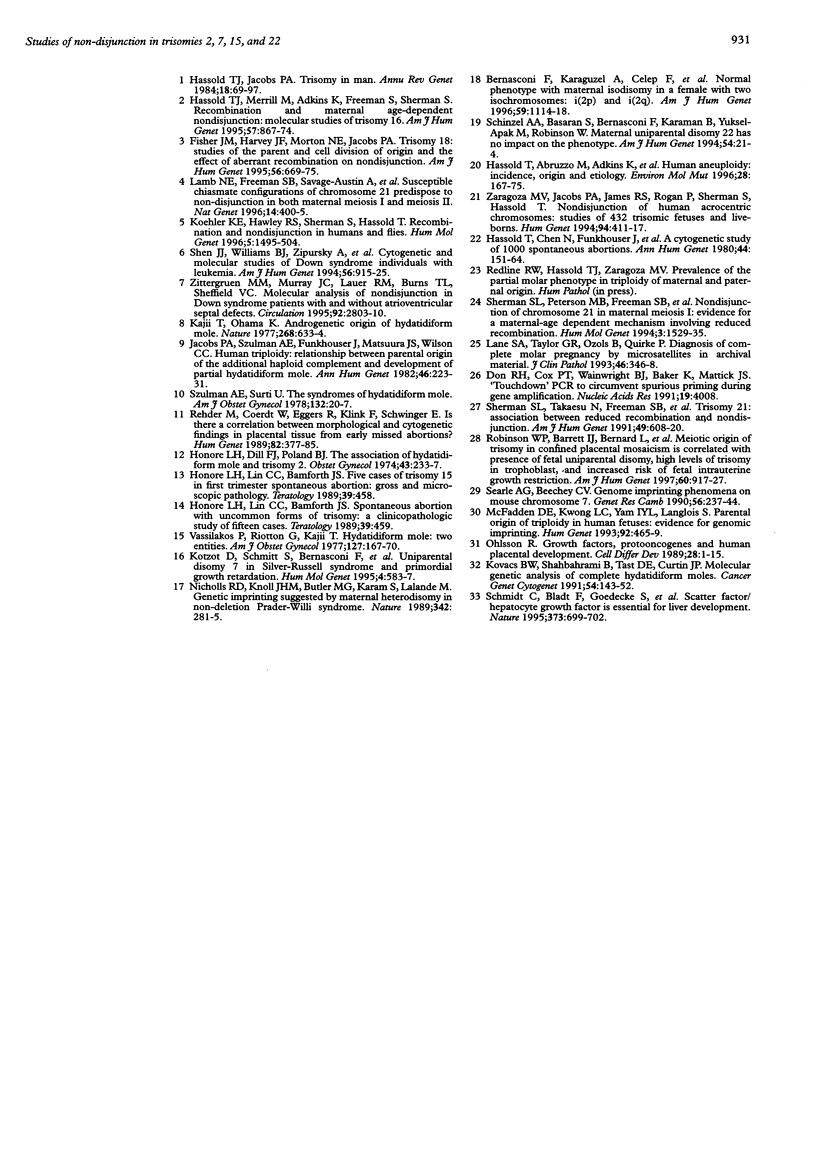
Images in this article
Selected References
These references are in PubMed. This may not be the complete list of references from this article.
- Bernasconi F., Karagüzel A., Celep F., Keser I., Lüleci G., Dutly F., Schinzel A. A. Normal phenotype with maternal isodisomy in a female with two isochromosomes: i(2p) and i(2q) Am J Hum Genet. 1996 Nov;59(5):1114–1118. [PMC free article] [PubMed] [Google Scholar]
- Fisher J. M., Harvey J. F., Morton N. E., Jacobs P. A. Trisomy 18: studies of the parent and cell division of origin and the effect of aberrant recombination on nondisjunction. Am J Hum Genet. 1995 Mar;56(3):669–675. [PMC free article] [PubMed] [Google Scholar]
- Hassold T. J., Jacobs P. A. Trisomy in man. Annu Rev Genet. 1984;18:69–97. doi: 10.1146/annurev.ge.18.120184.000441. [DOI] [PubMed] [Google Scholar]
- Hassold T., Abruzzo M., Adkins K., Griffin D., Merrill M., Millie E., Saker D., Shen J., Zaragoza M. Human aneuploidy: incidence, origin, and etiology. Environ Mol Mutagen. 1996;28(3):167–175. doi: 10.1002/(SICI)1098-2280(1996)28:3<167::AID-EM2>3.0.CO;2-B. [DOI] [PubMed] [Google Scholar]
- Hassold T., Chen N., Funkhouser J., Jooss T., Manuel B., Matsuura J., Matsuyama A., Wilson C., Yamane J. A., Jacobs P. A. A cytogenetic study of 1000 spontaneous abortions. Ann Hum Genet. 1980 Oct;44(Pt 2):151–178. doi: 10.1111/j.1469-1809.1980.tb00955.x. [DOI] [PubMed] [Google Scholar]
- Hassold T., Merrill M., Adkins K., Freeman S., Sherman S. Recombination and maternal age-dependent nondisjunction: molecular studies of trisomy 16. Am J Hum Genet. 1995 Oct;57(4):867–874. [PMC free article] [PubMed] [Google Scholar]
- Jacobs P. A., Szulman A. E., Funkhouser J., Matsuura J. S., Wilson C. C. Human triploidy: relationship between parental origin of the additional haploid complement and development of partial hydatidiform mole. Ann Hum Genet. 1982 Jul;46(Pt 3):223–231. doi: 10.1111/j.1469-1809.1982.tb00714.x. [DOI] [PubMed] [Google Scholar]
- Kajii T., Ohama K. Androgenetic origin of hydatidiform mole. Nature. 1977 Aug 18;268(5621):633–634. doi: 10.1038/268633a0. [DOI] [PubMed] [Google Scholar]
- Koehler K. E., Hawley R. S., Sherman S., Hassold T. Recombination and nondisjunction in humans and flies. Hum Mol Genet. 1996;5(Spec No):1495–1504. doi: 10.1093/hmg/5.supplement_1.1495. [DOI] [PubMed] [Google Scholar]
- Kotzot D., Schmitt S., Bernasconi F., Robinson W. P., Lurie I. W., Ilyina H., Méhes K., Hamel B. C., Otten B. J., Hergersberg M. Uniparental disomy 7 in Silver-Russell syndrome and primordial growth retardation. Hum Mol Genet. 1995 Apr;4(4):583–587. doi: 10.1093/hmg/4.4.583. [DOI] [PubMed] [Google Scholar]
- Kovacs B. W., Shahbahrami B., Tast D. E., Curtin J. P. Molecular genetic analysis of complete hydatidiform moles. Cancer Genet Cytogenet. 1991 Jul 15;54(2):143–152. doi: 10.1016/0165-4608(91)90202-6. [DOI] [PubMed] [Google Scholar]
- Lamb N. E., Freeman S. B., Savage-Austin A., Pettay D., Taft L., Hersey J., Gu Y., Shen J., Saker D., May K. M. Susceptible chiasmate configurations of chromosome 21 predispose to non-disjunction in both maternal meiosis I and meiosis II. Nat Genet. 1996 Dec;14(4):400–405. doi: 10.1038/ng1296-400. [DOI] [PubMed] [Google Scholar]
- Lane S. A., Taylor G. R., Ozols B., Quirke P. Diagnosis of complete molar pregnancy by microsatellites in archival material. J Clin Pathol. 1993 Apr;46(4):346–348. doi: 10.1136/jcp.46.4.346. [DOI] [PMC free article] [PubMed] [Google Scholar]
- McFadden D. E., Kwong L. C., Yam I. Y., Langlois S. Parental origin of triploidy in human fetuses: evidence for genomic imprinting. Hum Genet. 1993 Nov;92(5):465–469. doi: 10.1007/BF00216452. [DOI] [PubMed] [Google Scholar]
- Nicholls R. D., Knoll J. H., Butler M. G., Karam S., Lalande M. Genetic imprinting suggested by maternal heterodisomy in nondeletion Prader-Willi syndrome. Nature. 1989 Nov 16;342(6247):281–285. doi: 10.1038/342281a0. [DOI] [PMC free article] [PubMed] [Google Scholar]
- Ohlsson R. Growth factors, protooncogenes and human placental development. Cell Differ Dev. 1989 Oct;28(1):1–15. doi: 10.1016/0922-3371(89)90018-x. [DOI] [PubMed] [Google Scholar]
- Rehder H., Coerdt W., Eggers R., Klink F., Schwinger E. Is there a correlation between morphological and cytogenetic findings in placental tissue from early missed abortions? Hum Genet. 1989 Jul;82(4):377–385. doi: 10.1007/BF00274002. [DOI] [PubMed] [Google Scholar]
- Robinson W. P., Barrett I. J., Bernard L., Telenius A., Bernasconi F., Wilson R. D., Best R. G., Howard-Peebles P. N., Langlois S., Kalousek D. K. Meiotic origin of trisomy in confined placental mosaicism is correlated with presence of fetal uniparental disomy, high levels of trisomy in trophoblast, and increased risk of fetal intrauterine growth restriction. Am J Hum Genet. 1997 Apr;60(4):917–927. [PMC free article] [PubMed] [Google Scholar]
- Schmidt C., Bladt F., Goedecke S., Brinkmann V., Zschiesche W., Sharpe M., Gherardi E., Birchmeier C. Scatter factor/hepatocyte growth factor is essential for liver development. Nature. 1995 Feb 23;373(6516):699–702. doi: 10.1038/373699a0. [DOI] [PubMed] [Google Scholar]
- Searle A. G., Beechey C. V. Genome imprinting phenomena on mouse chromosome 7. Genet Res. 1990 Oct-Dec;56(2-3):237–244. doi: 10.1017/s0016672300035333. [DOI] [PubMed] [Google Scholar]
- Shen J. J., Williams B. J., Zipursky A., Doyle J., Sherman S. L., Jacobs P. A., Shugar A. L., Soukup S. W., Hassold T. J. Cytogenetic and molecular studies of Down syndrome individuals with leukemia. Am J Hum Genet. 1995 Apr;56(4):915–925. [PMC free article] [PubMed] [Google Scholar]
- Sherman S. L., Petersen M. B., Freeman S. B., Hersey J., Pettay D., Taft L., Frantzen M., Mikkelsen M., Hassold T. J. Non-disjunction of chromosome 21 in maternal meiosis I: evidence for a maternal age-dependent mechanism involving reduced recombination. Hum Mol Genet. 1994 Sep;3(9):1529–1535. doi: 10.1093/hmg/3.9.1529. [DOI] [PubMed] [Google Scholar]
- Vassilakos P., Riotton G., Kajii T. Hydatidiform mole: two entities. A morphologic and cytogenetic study with some clinical consideration. Am J Obstet Gynecol. 1977 Jan 15;127(2):167–170. doi: 10.1016/s0002-9378(16)33244-6. [DOI] [PubMed] [Google Scholar]
- Zaragoza M. V., Jacobs P. A., James R. S., Rogan P., Sherman S., Hassold T. Nondisjunction of human acrocentric chromosomes: studies of 432 trisomic fetuses and liveborns. Hum Genet. 1994 Oct;94(4):411–417. doi: 10.1007/BF00201603. [DOI] [PubMed] [Google Scholar]
- Zittergruen M. M., Murray J. C., Lauer R. M., Burns T. L., Sheffield V. C. Molecular analysis of nondisjunction in Down syndrome patients with and without atrioventricular septal defects. Circulation. 1995 Nov 15;92(10):2803–2810. doi: 10.1161/01.cir.92.10.2803. [DOI] [PubMed] [Google Scholar]



